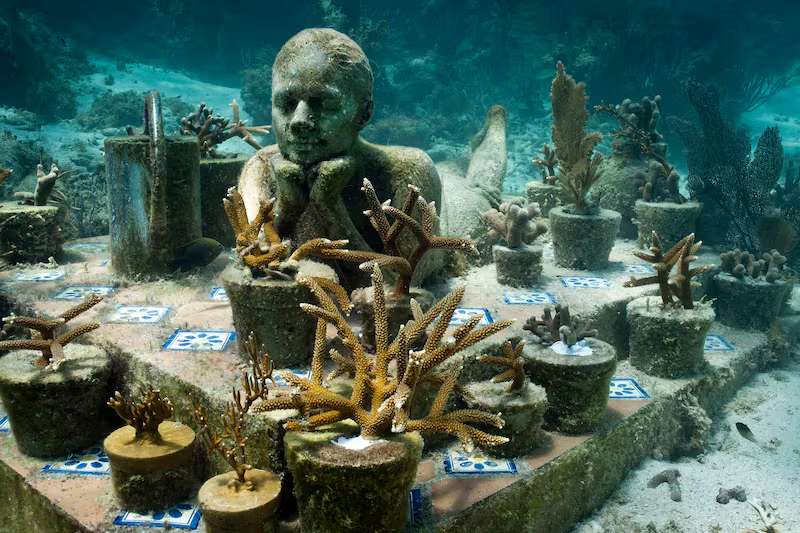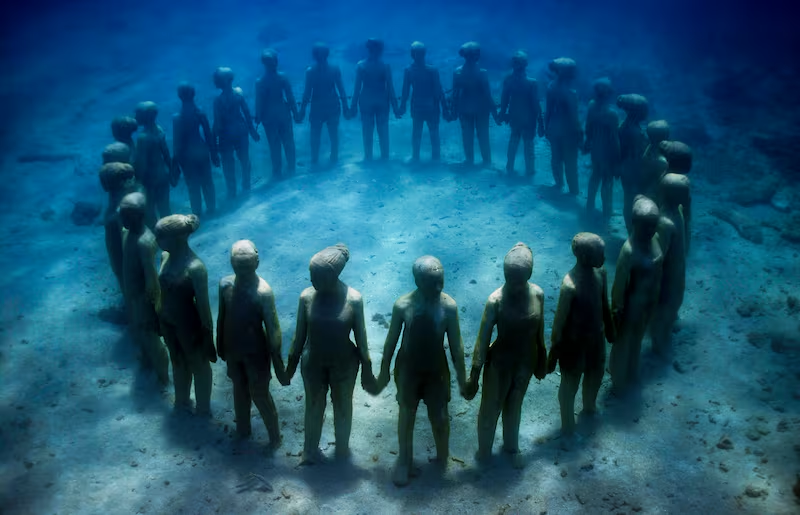Most artists spend their entire lives hoping to be exhibited at any number of the world’s reputable museums. But, Jason deCaires Taylor has spent the latter half of his professional career placing his sculptures where the majority of art-seekers wouldn’t normally think to look—at the bottom of the ocean.

Over the past decade, Taylor’s works cast from real-life models and everyday objects have begun to appear off the coasts of Grenada, Greece, and Mexico. These installations, while exciting to stumble upon or visit, are more than just to feed spectators’ visual appetites. Their purpose lies inherently deeper: providing the building blocks for sustaining a rapidly depleting coral reef environment.
Thirty-nine-year-old Taylor, who grew up in Malaysia, spent his childhood exploring the reefs and islands that populated his local habitat. Eventually, his family moved back to the U.K. While searching abandoned factories and dilapidated railway lines instead of the aquatic invasions of coral reefs, the artist’s fascination bloomed into something larger. He became interested in the way that nature reclaims human environments.
PHOTOS: Jason de Caires Taylor's Gorgeous Underwater Art (Photos)

Taylor spent his later youth creating graffiti art, which led him to enroll at the London Institute of Arts. While receiving his BA Honors in sculpture, his focus shifted to the intersection of art and the environment. “Street art gave me the ability to think of art as a temporal encounter,” Taylor says in the opening of this new book, The Underwater Museum. But, for his work now, the roles have been reversed. “Instead of leaving my mark on the environment with my work, the environment is leaving its mark on my work.”
The other jobs that Taylor has held throughout his life have also played a pivotal role in the overall production of the underwater pieces. After university, the artist spent several years as a diving instructor in Australia followed by a stint on set design and construction for concerts and arenas. These skills, coupled with the craftsmanship learned in art school, have all helped his most recent endeavors. Even his brief period as a paparazzo, as low of a moment as he jokingly says it was, gave him the tools he needed to create a visual diary of his work.
In 2006, Taylor began installing his first major underwater construction in Grenada. Each 6000kg sculpture is lowered to the seabed where it is drilled into the substrate to lessen the effects of turbulent weather. As the “world’s first underwater sculpture park,” 65 sculptures cover 200 square miles of seabed two miles north of St Georges. Collectively, these works attract marine life to an area that has sustained significant damage due to harsh weather conditions.
Accompanied by a guide, viewers can snorkel or scuba dive to the sculptures for an up-close look. For those who prefer to stay dry, glass bottom viewing boats are also a popular option. At five meters deep, Granada’s Grace Reef depicts 16 female Grenadian forms lying flat on the ocean floor. Depending on currents and other environmental factors, the sculptures’ visibility alternates, surprising viewers with their random appearances. Slightly deeper, a man sits alone at a table with a typewriter—The Lost Correspondent. Taylor’s most widely acclaimed piece, Vicissitudes, stands nearby in a ghostly circle of 26 children holding hands.
While the installation is undoubtedly a wonder to see—it is listed on National Geographic’s Top 25 Wonders of the World—its positive ecological impact far outweighs its aesthetic design. Using a mixture of marine grade ingredients, Taylor’s pH-neutral concrete sculptures act as an artificial reef attracting corals and fish species while also diverting tourists away from natural reefs that are suffering from environmental distress.
It is widely believed that coral reefs only exist in a very tiny percentage of the ocean. Yet, they are thought to be home to a third of all marine species. Simply put, their eradication could have a major effect on the global span of life far beyond the marine habitat. “It [became] of the utmost importance to me,” Taylor stated, “that what I was doing would benefit the natural world and not needlessly occupy space on an already cluttered planet.”
Through this, Taylor’s sculptures are constantly mutating. As more time passes, the coral that attach give the works entirely new shape, texture, and color. Their human forms disappear as the works seamlessly transition from sculptures to fully functional habitats in a starkly deprived ecosystem.
In 2009, Taylor’s ambitions grew even bigger when he was commissioned to create the world’s largest underwater sculpture museum. Located off the coast of Isla Mujeres, the Cancun Underwater Museum (MUSA) features over 450 permanent life-size sculptures and attracts as many as 150,000 visitors a year.
In his most ambitious work to date, four hundred of these casts make up The Silent Evolution and represent people from all walks of life from a span of past decades. Algae, sponges and coral now cover nuns, small children, and the elderly upper class.
The Garden of Hope is a small, but memorable installation. A young girl can be seen lying on garden patio steps, surrounded by various plant pots. Taylor has rescued various coral cuttings from damaged reef systems nearby, placing them inside the vessels to promote re-growth. The work becomes a fusion of art and science, symbolizing a revitalized kinship with human’s involvement with the environment.
In addition to his environmental efforts and partnerships with various educational facilities, Taylor has also been commissioned by internationally known celebrities to create one-of-a-kind works. The Musician, located in Copperfield Bay in the Bahamas, was made in collaboration with musician David Copperfield. It features a mirror finished replica of a Steinway Grand and incorporates innovative multi-sensorial audio technology.
Currently, Taylor is planning an expansion of his works to other parts of the globe. If all goes his way, his art will not only promote re-growth of a severely damaged ecosystem, but also awareness of pleasurable techniques and alternatives to help save it.
‘The Underwater Museum,’ a new book out this month, highlights Jason deCaires Taylor’s many projects in full color detail.





